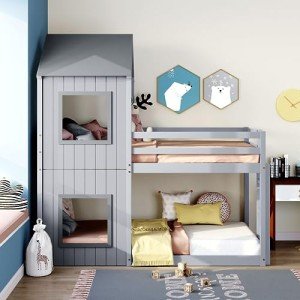Exploring Bunk Beds: A Comprehensive Guide
Bunk beds have long been a staple in kids's bedrooms, dorms, and even homes with restricted space. Not just do they supply a practical sleeping service, however they also develop an enjoyable and creative environment for kids and a great space-saver for adults and families. This short article will explore everything you require to learn about bunk beds, from types and products to safety tips and buying suggestions.
Table of Contents
- Types of Bunk Beds
- Standard Bunk Beds
- Loft Beds
- Triple Bunk Beds
- L-Shaped Bunk Beds
- Material Options
- Wood
- Metal
- Safety Considerations
- Purchasing Guide
- Frequently asked questions
Kinds Of Bunk Beds
Bunk beds are available in different styles to match various requirements and choices. Here's a breakdown of the most typical types:
Conventional Bunk Beds
Standard bunks usually include two beds stacked vertically on top of one another. These beds are perfect for siblings sharing a room or for maximizing sleeping space in guest rooms.
Loft Beds
Loft beds stand similarly to conventional bunk beds however do not have a lower sleeping area. Instead, they frequently integrate a desk or seating location underneath, making them a great choice for small rooms requiring multifunctionality.
Triple Bunk Beds
Triple bunk beds are created for three occupants, with beds stacked in a three-tier setup. These are less common however can be an enjoyable solution for big households or pajama parties.
L-Shaped Bunk Beds
With one bed positioned horizontally and the other vertically, L-shaped bunk beds are frequently equipped with additional functions such as desks or storage drawers and can match corner areas in a space.
Contrast of Bunk Bed Types
| Bed Type | Perfect Use | Description |
|---|---|---|
| Conventional | Shared bedrooms or guest spaces | Two beds stacked vertically |
| Loft | Little rooms needing multi-purpose space | Upper bed with open space underneath |
| Triple | Large households or slumber parties | Three beds stacked vertically |
| L-Shaped | Corner or versatile areas | A combination of vertical and horizontal beds |
Material Options
Bunk beds are manufactured from various products, with wood and metal being the most common. Each product has its pros and cons.
Wood
- Resilience: Generally robust and can endure years of use.
- Aesthetic Appeal: Offers a timeless appearance that can blend with numerous decors.
- Weight Capacity: Typically tougher; can support heavier weights.
- Disadvantages: May be more pricey than metal options and can be susceptible to scratches.
Metal
- Sturdiness: Generally light-weight and simple to move however still tough.
- Modern Design: Often comes in smooth designs, making it appealing for contemporary areas.
- Cost-efficient: Usually more economical than wooden alternatives.
- Drawbacks: Can be cold to the touch in winters and may not have the very same visual appeal for some buyers.
Safety Considerations
When it pertains to bunk beds, security can not be neglected. Here are essential security suggestions to keep in mind:
- Guardrails: Ensure that the leading bunk has guardrails on both sides to prevent falls.
- Strong Construction: Check for a strong construct and strong materials to endure weight and movement.
- Weight Limit: Adhere to the manufacturer's weight limitation for both the upper and lower bunks.
- Ladder Design: Choose bunks with a safe, easy-to-climb ladder and avoid any sharp edges or rungs.
- Age Restrictions: Most manufacturers suggest that children under the age of six need to not oversleep the upper bunk.
Purchasing Guide
When looking for bunk beds, think about the list below factors to find the very best suitable for your requirements:
- Space Availability: Measure the room size and ceiling height, making sure there is sufficient space for the leading bunk.
- Bed Size: Decide in between twin, complete, or larger sizes based upon your requirements and the size of the space.
- Design Preference: Consider the overall design of the bedroom to discover an appropriate design.
- Ease of Setup: Look for a bunk bed that is uncomplicated to put together.
- Budget: Bunk beds are available in numerous price varieties, so figure out a budget before starting your search.
FAQs
1. What is the recommended age for children to sleep on the top bunk?
Children aged six and older are generally suggested to sleep on the top bunk to lessen the danger of falls.
2. How can I make my bunk bed much safer?
To improve security, guarantee guardrails are effectively set up and inspect that the bed is put on a flat surface. In addition, motivate children to use the ladder thoroughly.
3. Can I transform a bunk bed into two different beds?
Many bunk beds are created to be convertible. Inspect the maker's specifications for convertibility functions.
4. What accessories are readily available for bunk beds?
Common accessories include beddings, storage drawers, staircases instead of ladders, and tented canopies for an enjoyable visual appeal.
5. How do I preserve my bunk bed?
Regular look for loose screws or structural integrity can assist make sure safety. Dust this article and tidy spills immediately to keep the products in good condition.
Bunk beds are versatile and a space-efficient service for numerous living circumstances, from kids's spaces to visitor accommodations. With many styles and materials readily available, prospective buyers have a wealth of options to think about, making sure a mix of functionality and looks. By focusing on security and following the ideas described in this guide, people can discover the right bunk bed that matches their space and way of life, all while developing an enjoyable sleeping environment.

